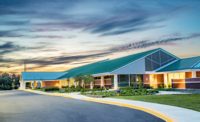Hospital Earns High-Level LEED Certification




Humber River Hospital has achieved LEED Gold certification through the Canada Green Building Council (CaGBC), bringing much deserved recognition to North America’s first fully-digital healthcare facility.
“Humber River Hospital was constrained by the limitations of aging technology and building infrastructure,” said Jerry Jeter, health principal at HDR and lead architect on the project. “The new hospital uses technology to enhance all aspects of quality patient care delivery, and the recognition of Humber River Hospital as a LEED Gold facility validates the building’s environmental consciousness. In addition to the high-quality care the Humber River physicians deliver to their patients, the building raises the sustainability bar for development.”
The new Humber River Hospital was designed to link healthcare delivery with the environment. Adhering to LEED guidelines, the hospital also meets the requirements for the Tier 1 of the City of Toronto’s Green Standard (TGS).
“We designed and built our new hospital on three core principles: Lean, Green and Digital,” Humber River Hospital President & CEO Barb Collins said in a news release announcing the achievement. “We are grateful to the Canada Green Building Council for certifying that this work was done to a very, very high standard.”
Design elements that respond to climate conditions, including prevailing winds, site orientation, seasonal sun paths and precipitation, surface water drainage and solar gain highlight the new facility. A traffic demand strategy was developed in partnership with Smart Commute Toronto to promote alternative means of access to the site, including bike lockers, public transportation access and car-pooling or ride sharing.
Over half of all rooftops at the hospital are vegetated and help manage storm water, reduce the heat island effect, improve air quality and beautify the views from inpatient rooms. Roofs without gardens are white to minimize heat gain.
“It is difficult to find an organization so committed to ensuring that their facility fits into the environment and leaves the tiniest carbon footprint possible,” Jeter said. “This LEED Gold certification achievement is beyond the intended Silver certification and is well deserved.”
Highly efficient plumbing fixtures such as low-flow toilets, faucets and showers decrease indoor water use by 35 percent and adhesives and sealants, paints and coatings, and carpets are all low-emission materials.
“The project was required to meet or exceed an Energy Use Intensity (EUI) target of 100 kBtu/SF/year, the new entry point for truly high performance inpatient Healthcare facilities. The HDR design team took a holistic approach to optimize all building systems, both architectural and engineering, to meet this target and achieve a roughly 55 percent reduction from a typical hospital,” said Colin Rohlfing, vice president and director of sustainable development at HDR. “With additional system commissioning and refinement through an advanced Building Automation System, Humber River believes that they can achieve an additional 30 percent savings from the design benchmark. HDR, our project teams and forward thinking clients like Humber River are helping the industry continuously move this performance bar higher.”
Humber River Hospital’s sustainable design reduces operating costs in addition to the organization’s carbon footprint and confirms the work done to create such a facility sets a very high standard for hospitals that follow.
Looking for a reprint of this article?
From high-res PDFs to custom plaques, order your copy today!







